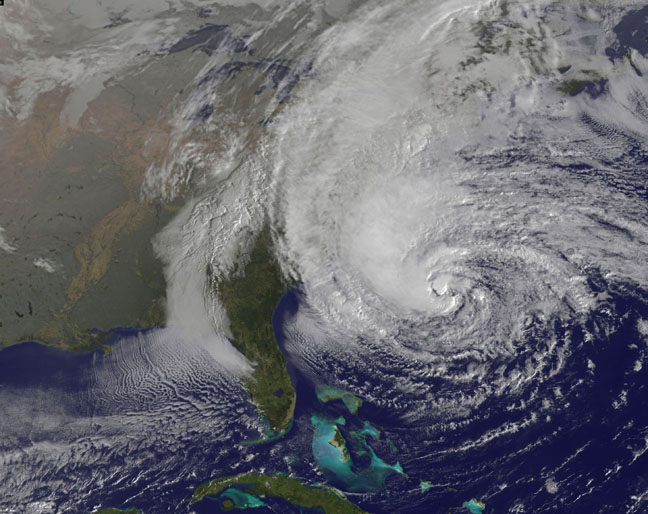SUMMARY
This is AI generated summarization, which may have errors. For context, always refer to the full article.

WASHINGTON DC, United States – US President Barack Obama warned Americans on Sunday, October 29, to take Hurricane Sandy “very seriously” as authorities prepared a virtual shutdown of the Eastern Seaboard due to the impending mega-storm.
More than 5,000 flights out of East Coast hubs were cancelled and ground transport was due to grind to a halt on Monday, October 29, as non-essential government staff were told not to show up for work and public schools were closed.
“My first message is to all people across the Eastern Seaboard, mid-Atlantic going north. You need to take this very seriously,” Obama said, urging everyone in the vast region to heed the instructions of their local authorities.
The president, who spoke after being briefed at the headquarters of the Federal Emergency Management Agency (FEMA), cautioned that Sandy was a slow-moving storm that certain areas would take a long time to recover from.
Residents of the densely-populated East Coast, home to 50 million Americans, stocked up on emergency provisions like batteries and water as forecasters warned of widespread damage, mass power outages and disastrous flooding.
After laying waste to parts of the Caribbean, where it claimed 66 lives, most of them in Cuba and Haiti, Hurricane Sandy was predicted to come crashing ashore in New Jersey and Delaware late Monday and early Tuesday.
New York state authorities ordered evacuations for hundreds of thousands of people in low-lying areas, including 375,000 people in New York City alone.
Forecasters warned that New York Harbor and the Long Island Sound could see seawater surges of up to 11 feet (3.35 meters) above normal levels.
“This is a serious and dangerous storm,” New York Mayor Michael Bloomberg told a news conference after state Governor Andrew Cuomo ordered subway, buses and commuter trains to close down from Sunday night.
Amtrak, which operates trains and buses up and down the coast, said all services would be suspended on Monday.
Forecasters warned that the massive storm was far larger and more dangerous than last year’s devastating Hurricane Irene that claimed 47 lives and caused an estimated $15 billion in damage.
It was the sheer size of Hurricane Sandy that was so alarming, and the fact that it was expected to collide with a cold front moving south from Canada just as it makes landfall.
“Sandy will be more like a large nor’easter on steroids,” warned Alex Sosnowski, a senior meteorologist for Accuweather.com.
The storm, currently packing hurricane force winds upwards of 75 miles per hour (120 kilometers per hour), was about 530 miles (850 kilometers) south of New York at 2100 GMT Sunday, the National Hurricane Center said.
Winds stretched out more than 500 miles (800 kilometers) from the storm’s center, meaning everywhere from South Carolina to southern Canada was due to be affected and heavy rains and snow were expected as far inland as Ohio.
“The system is so large that I would say millions of people are at least in areas that have some chance of experiencing either flash flooding or river flooding,” National Hurricane Center director Rick Knabb warned.
Nine days out from election day, the hurricane also threw the US presidential contest into disarray, with Obama and Republican challenger Mitt Romney cancelling events and preparing for the unexpected fallout.
Romney cancelled appearances in Virginia to head for Ohio before the hurricane’s arrival, while Obama moved up his planned departure to Florida in order to be back in Washington before the storm made landfall.
Residents from Washington DC to New York to Boston queued for bottles of water, bread, fresh foods, batteries in long lines that stretched out the doors of some supermarkets.
Television images from North Carolina’s Outer Banks, a chain of low lying islands, showed wild surf and torrential rain already hitting the coast.
Flooding had also reached parts of southern Virginia. One Chesapeake Bay-area resident posted a photo on Facebook showing waters lapping well up onto the slide of her backyard swingset.
The photo was taken well before high tide, Petra Holden told AFP, saying when the tide comes in, “its actually going to get a lot worse, because its a full moon.”
Current projections showed the storm making landfall early Tuesday on the Delaware or New Jersey coast, then bending north and inland as it merges with the cold front descending from Canada.
Weather experts say that the collision of Sandy with the cold front could create a super-charged storm bringing floods, high winds and even heavy snow across a swath of eastern states and as far inland as Ohio.
Public schools were to be closed for millions of students Monday in districts from Washington through Boston.
Governors declared states of emergency in Connecticut, Maryland, Massachusetts, New York, New Jersey, Pennsylvania, Virginia, the US capital Washington and parts of North Carolina. – Naomi Seck, Agence France-Presse
Add a comment
How does this make you feel?
There are no comments yet. Add your comment to start the conversation.